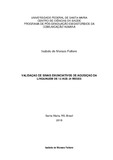| dc.creator | Fattore, Isabela de Moraes | |
| dc.date.accessioned | 2021-05-06T11:55:51Z | |
| dc.date.available | 2021-05-06T11:55:51Z | |
| dc.date.issued | 2018-07-23 | |
| dc.identifier.uri | http://repositorio.ufsm.br/handle/1/20795 | |
| dc.description.abstract | This dissertation aimed to validate the enunciative signs of language acquisition (SEAL) for the age group of 13 to 24 months. To this end, we counted on the collaboration of judges specialized in validation of content and the longitudinal monitoring of 77 mother-infant dyads between 13 and 17 months (SEAL Phase 3) and 89 dyads between 18 and 24 months (Phase 4 ), accompanied by means of filming their playful and dialogical interaction. The filming was analyzed by two speech therapists experienced in babies' clinic and able to understand the enunciative proposal of language acquisition. For statistical analysis, the computational applications STATISTICA 9.1 and PASW 17.0 were used. As a result, the preliminary validation of two instruments, corresponding to two age groups denominated Phase 3 - 13 to 17 months composed of 7 items and Phase 4 - 18 to 24 months composed of 5 items was obtained. After factorial analysis, in Phase 3, we obtained two factors: the one factor representing the child as a subject in language, sustained in the dialogue by the adult, progressing lexically; the factor two, consisting of a single item that encompasses a set of signals indicative of typical language development. In Phase 4, all items made up a single factor, indicating that all evidence a similar direction of analysis. The results demonstrate that the signs of these two phases can differentiate groups regarding the acquisition of language, which makes them promising instruments in the process of early identification if something is not going well in the process of children's linguistic constitution. | eng |
| dc.description.sponsorship | Coordenação de Aperfeiçoamento de Pessoal de Nível Superior - CAPES | por |
| dc.language | por | por |
| dc.publisher | Universidade Federal de Santa Maria | por |
| dc.rights | Attribution-NonCommercial-NoDerivatives 4.0 International | * |
| dc.rights.uri | http://creativecommons.org/licenses/by-nc-nd/4.0/ | * |
| dc.subject | Desenvolvimento infantil | por |
| dc.subject | Linguagem | por |
| dc.subject | Fonoaudiologia | por |
| dc.subject | Child development | eng |
| dc.subject | Language acquistion | eng |
| dc.subject | Speech and language therapist | eng |
| dc.title | Validação de sinais enunciativos de aquisição da linguagem de 13 aos 24 meses | por |
| dc.title.alternative | Valuation of enunative signs of language acquisition for children from 13 to 24 months | eng |
| dc.type | Dissertação | por |
| dc.description.resumo | Esta pesquisa teve como objetivo validar os sinais enunciativos de aquisição da linguagem (SEAL) para a faixa etária de 13 a 24 meses. Para tal, contou-se com a colaboração de juízes especialistas na validação de conteúdo e com o acompanhamento longitudinal de 77 díades mãe-bebê entre 13 e 17 meses (Fase 3 do SEAL) e 89 díades entre 18 e 24 meses (Fase 4), registrados por meio de filmagens das interações lúdicas e dialógicas. As filmagens foram analisadas por duas fonoaudiólogas experientes em clínica de bebês, segundo a perspectiva enunciativa de aquisição da linguagem. Para análise estatística foram usados os aplicativos computacionais STATISTICA 9.1 e PASW 17.0. Como resultado, obteve-se a validação preliminar de dois instrumentos, correspondentes a duas faixas etárias denominados Fase 3 – 13 a 17 meses composto por 7 sinais e Fase 4 – 18 a 24 meses composta por 5 sinais. Após análise fatorial, na Fase 3, obtivemos dois fatores: o fator 1 representando a criança enquanto sujeito na linguagem, sustentada no diálogo pelo adulto e progredindo lexicalmente; o fator 2, composto por um único sinal que engloba um conjunto de sinais indicativos de desenvolvimento típico de linguagem. Na Fase 4, todos os sinais compuseram um único fator, indicando que todos evidenciam uma direção de análise semelhante. Os resultados demonstram que os sinais dessas duas fases podem diferenciar grupos quanto à aquisição da linguagem, o que os torna instrumentos promissores no processo de identificação precoce se algo não vai bem no processo de constituição linguística infantil. | por |
| dc.contributor.advisor1 | Souza, Ana Paula Ramos de | |
| dc.contributor.advisor1Lattes | http://lattes.cnpq.br/7859963389320763 | por |
| dc.contributor.advisor-co1 | Moraes, Anaelena Bragança de | |
| dc.contributor.referee1 | Fedosse, Elenir | |
| dc.contributor.referee2 | Crestani, Anelise Henrich | |
| dc.creator.Lattes | http://lattes.cnpq.br/0427702425055452 | por |
| dc.publisher.country | Brasil | por |
| dc.publisher.department | Fonoaudiologia | por |
| dc.publisher.initials | UFSM | por |
| dc.publisher.program | Programa de Pós-Graduação em Distúrbios da Comunicação Humana | por |
| dc.subject.cnpq | CNPQ::CIENCIAS DA SAUDE::FONOAUDIOLOGIA | por |
| dc.publisher.unidade | Centro de Ciências da Saúde | por |



